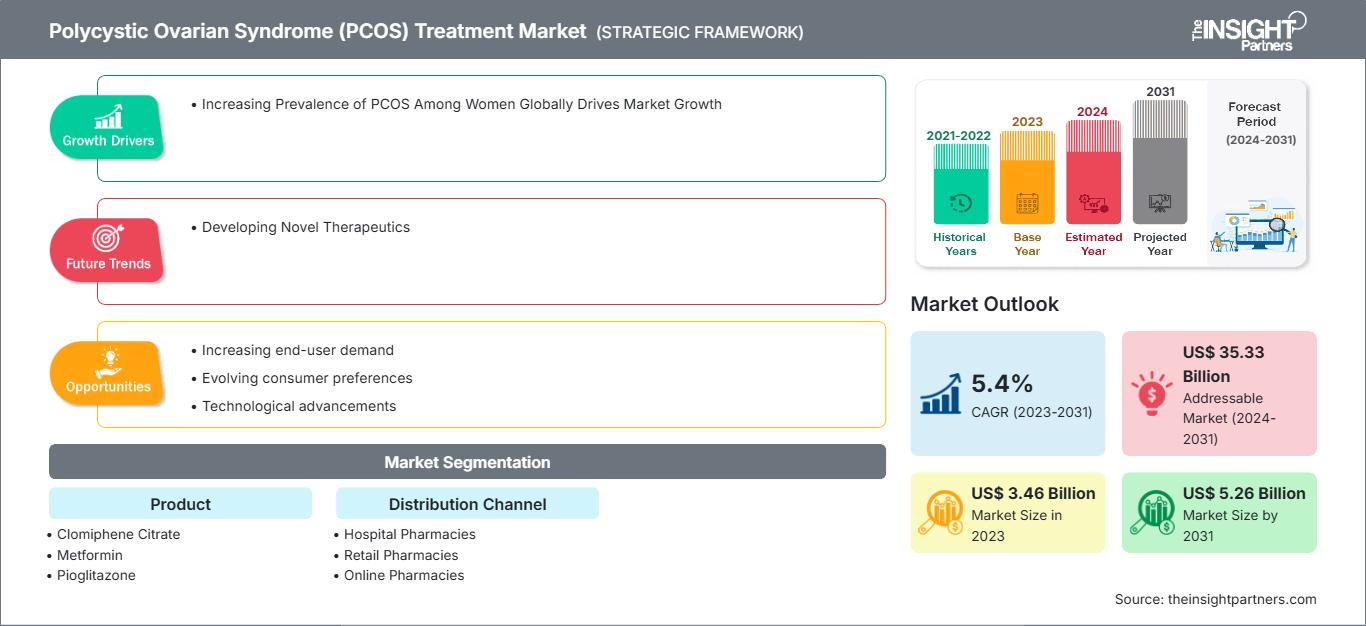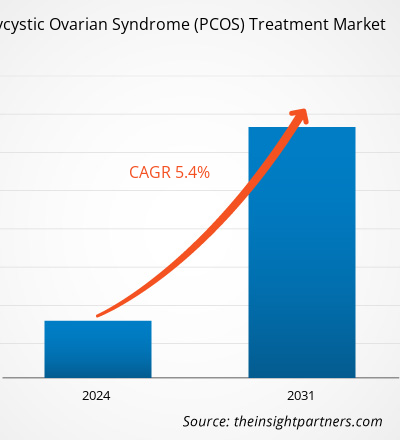Der Markt für die Behandlung des polyzystischen Ovarialsyndroms (PCOS) wird bis 2031 voraussichtlich ein Volumen von 7,48 Milliarden US-Dollar erreichen. Es wird erwartet, dass der Markt im Zeitraum 2025–2031 eine durchschnittliche jährliche Wachstumsrate (CAGR) von 5,8 % verzeichnen wird.
Die weltweit zunehmende Verbreitung des polyzystischen Ovarialsyndroms ( PCOS ) und die damit einhergehenden, signifikant steigenden Gesundheitsausgaben für dessen Behandlung treiben das Wachstum des Marktes für PCOS -Therapien an . Allein in den USA leiden etwa 6 Millionen Frauen an PCOS , einer häufigen Hormonstörung. Diese erhöht das Risiko für verschiedene Erkrankungen wie Gebärmutterkrebs, Bluthochdruck, Typ-2-Diabetes, Unfruchtbarkeit und Schlaganfall. Die Endocrine Society schätzt, dass die Diagnose und Behandlung von PCOS , der häufigsten Hormonstörung bei Frauen im gebärfähigen Alter, im Jahr 2020 in den USA Kosten in Höhe von 8 Milliarden US-Dollar verursachen wird.
Die Entwicklung neuartiger Therapien wird im Prognosezeitraum neue Trends auf dem Markt für die Behandlung des polyzystischen Ovarialsyndroms ( PCOS ) mit sich bringen.
Wachstumstreiber:
Die weltweit zunehmende Verbreitung des polyzystischen Ovarialsyndroms ( PCOS ) bei Frauen treibt das Wachstum des Marktes für die Behandlung dieses Syndroms an.
Das polyzystische Ovarialsyndrom ( PCOS ) ist eine häufige, multifaktorielle Hormonstörung bei Frauen. Laut Weltgesundheitsorganisation (WHO) sind schätzungsweise 8–13 % der Frauen im gebärfähigen Alter von PCOS betroffen. Weltweit ist PCOS die häufigste Ursache für Anovulation und eine der Hauptursachen für Unfruchtbarkeit. Zudem bleiben etwa 70 % der betroffenen Frauen ohne Diagnose . Ein ungesunder Lebensstil , eine ungesunde Ernährung und bestimmte Umweltfaktoren können PCOS auslösen . Übergewicht ist ein wesentlicher Risikofaktor für PCOS , da überschüssiges Körperfett den Hormonspiegel und die Insulinsensitivität beeinträchtigen und so zur Entstehung der Erkrankung beitragen kann. Angesichts der weltweit zunehmenden Adipositas-Epidemie steigt das Risiko für Frauen, an PCOS zu erkranken . Laut dem Welt-Adipositas-Atlas 2022 der Welt-Adipositas-Föderation werden bis 2030 weltweit mehr als eine Milliarde Menschen von Adipositas betroffen sein, darunter jede fünfte Frau.
Darüber hinaus hat die zunehmende Verbreitung des polyzystischen Ovarialsyndroms (PCOS) zu einer steigenden Nachfrage nach wirksamen Behandlungsmöglichkeiten geführt. Verschiedene medikamentöse und nicht-medikamentöse PCOS -Therapien stehen zur Verfügung, um den Hormonspiegel zu regulieren, die Insulinsensitivität zu verbessern und andere zugrunde liegende Faktoren, die zu PCOS beitragen, zu behandeln . Somit treibt die weltweit steigende Verbreitung von PCOS bei Frauen das Wachstum des Marktes für die Behandlung des polyzystischen Ovarialsyndroms ( PCOS ) an.
Zurückhaltung:
Die begrenzte Verfügbarkeit von FDA-zugelassenen Medikamenten speziell für PCOS behindert den Markt für die Behandlung des polyzystischen Ovarialsyndroms ( PCOS ).
Es gibt nur eine begrenzte Anzahl von Medikamenten, die von der US-amerikanischen Arzneimittelbehörde FDA zugelassen sind und speziell zur Behandlung der komplexen Symptome und zugrunde liegenden hormonellen Ungleichgewichte beim polyzystischen Ovarialsyndrom ( PCOS ) entwickelt wurden. Trotz der hohen Prävalenz von PCOS und seiner erheblichen Auswirkungen auf die Gesundheit, Fruchtbarkeit und Lebensqualität von Frauen stehen relativ wenige von der FDA zugelassene Medikamente (Off-Label-Anwendungen) zur Behandlung dieser Erkrankung zur Verfügung. Der Mangel an FDA-zugelassenen Medikamenten stellt eine Herausforderung für Ärzte und Patientinnen dar, die nach wirksamen und evidenzbasierten PCOS- Therapien suchen. Zwar ist die Off-Label-Anwendung bestimmter Medikamente wie oraler Kontrazeptiva, Insulinsensitizer und Antiandrogene zur Linderung von PCOS- Symptomen üblich, doch schränkt das Fehlen spezifischer Therapien die Möglichkeiten einer umfassenden Behandlung der Erkrankung ein. Daher hemmt die begrenzte Verfügbarkeit von FDA-zugelassenen, speziell für PCOS indizierten Medikamenten das Wachstum des Marktes für die Behandlung des polyzystischen Ovarialsyndroms ( PCOS ).anti-androgens is common in managing
Sie erhalten eine kostenlose Anpassung aller Berichte – einschließlich Teilen dieses Berichts, Länderanalysen und Excel-Datenpaketen – sowie attraktive Angebote und Rabatte für Start-ups und Universitäten.
Markt für die Behandlung des polyzystischen Ovarialsyndroms ( PCOS ): Strategische Einblicke

-
Ermitteln Sie die wichtigsten Markttrends dieses Berichts.Diese KOSTENLOSE Probe beinhaltet eine Datenanalyse, die von Markttrends bis hin zu Schätzungen und Prognosen reicht.
Berichtssegmentierung und -umfang:
Die Marktanalyse für die Behandlung des polyzystischen Ovarialsyndroms (PCOS) wurde unter Berücksichtigung der folgenden Segmente durchgeführt: Produkt und Vertriebskanal.
Der Markt für die Behandlung des polyzystischen Ovarialsyndroms (PCOS) ist nach Produkten in Clomifencitrat, Metformin, Pioglitazon, orale Kontrazeptiva und Sonstige unterteilt. Metformin hielt 2023 den größten Marktanteil. Für Clomifencitrat wird zudem die höchste durchschnittliche jährliche Wachstumsrate (CAGR) im Prognosezeitraum erwartet.
Der Markt für die Behandlung des polyzystischen Ovarialsyndroms (PCOS) ist nach Vertriebskanal in Krankenhausapotheken, Einzelhandelsapotheken und Online-Apotheken unterteilt. Krankenhausapotheken hielten 2023 den größten Marktanteil und werden voraussichtlich im Prognosezeitraum die höchste durchschnittliche jährliche Wachstumsrate (CAGR) verzeichnen.
Regionalanalyse:
Geografisch betrachtet umfasst der Bericht zum Markt für die Behandlung des polyzystischen Ovarialsyndroms (PCOS) Nordamerika, Europa, den asiatisch-pazifischen Raum, Süd- und Mittelamerika sowie den Nahen Osten und Afrika. Nordamerika hielt 2023 den größten Marktanteil. Die zunehmende Nutzung neuester Medizintechnik, die steigende Prävalenz von PCOS und die wachsenden Produktinnovationen führender Anbieter tragen zum Wachstum des PCOS-Behandlungsmarktes in Nordamerika bei. Laut dem US-amerikanischen Gesundheitsministerium ist PCOS eine häufige Ursache für weibliche Unfruchtbarkeit in den USA und betrifft etwa 6 bis 12 % (rund 5 Millionen) der US-amerikanischen Frauen im gebärfähigen Alter. Laut der Studie „Incidence, prevalence, and trends in polycystic ovary syndrome diagnosis“, die im Juli 2023 im American Journal of Obstetrics and Gynecology veröffentlicht wurde, liegt die Inzidenzrate von PCOS in den USA bei 42,5 Fällen pro 10.000 Einwohner jährlich. Darüber hinaus bieten verschiedene Organisationen im Land umfassende Untersuchungen an, schaffen Bewusstsein für das polyzystische Ovarialsyndrom (PCOS) und konzentrieren sich auf die Forschung in diesem Bereich. Beispielsweise forscht das UCSF Center for Reproductive Health aktiv an den Ursachen von PCOS. Die hohe Prävalenz von PCOS und die Präsenz von Organisationen, die sich auf Forschung und Aufklärung konzentrieren, begünstigen somit das Wachstum des Marktes für PCOS-Behandlungen.
Markteinblicke in die Behandlung des polyzystischen Ovarialsyndroms (PCOS)
Die regionalen Trends und Einflussfaktoren auf den Markt für die Behandlung des polyzystischen Ovarialsyndroms (PCOS) im gesamten Prognosezeitraum wurden von den Analysten von The Insight Partners eingehend erläutert. Dieser Abschnitt behandelt außerdem die Marktsegmente und die geografische Verteilung des PCOS-Behandlungsmarktes in Nordamerika, Europa, Asien-Pazifik, dem Nahen Osten und Afrika sowie Süd- und Mittelamerika.
Berichtsumfang zum Markt für die Behandlung des polyzystischen Ovarialsyndroms (PCOS)
| Berichtattribute | Details |
|---|---|
| Marktgröße im Jahr 2024 | US$ XX Milliarden |
| Marktgröße bis 2031 | 7,48 Milliarden US-Dollar |
| Globale durchschnittliche jährliche Wachstumsrate (2025 - 2031) | 5,8 % |
| Historische Daten | 2021-2023 |
| Prognosezeitraum | 2025–2031 |
| Abgedeckte Segmente |
Nebenprodukt
|
| Abgedeckte Regionen und Länder |
Nordamerika
|
| Marktführer und wichtige Unternehmensprofile |
|
Marktdichte bei der Behandlung des polyzystischen Ovarialsyndroms (PCOS): Auswirkungen auf die Geschäftsdynamik verstehen
Der Markt für die Behandlung des polyzystischen Ovarialsyndroms (PCOS) wächst rasant, angetrieben durch die steigende Nachfrage der Endverbraucher. Gründe hierfür sind unter anderem sich wandelnde Verbraucherpräferenzen, technologische Fortschritte und ein wachsendes Bewusstsein für die Vorteile der Produkte. Mit steigender Nachfrage erweitern Unternehmen ihr Angebot, entwickeln innovative Lösungen, um den Bedürfnissen der Verbraucher gerecht zu werden, und nutzen neue Trends, was das Marktwachstum zusätzlich beflügelt.

- Überblick über die wichtigsten Akteure auf dem Markt für die Behandlung des polyzystischen Ovarialsyndroms (PCOS).
Branchenentwicklungen und Zukunftschancen:
Nachfolgend sind einige strategische Entwicklungen führender Akteure auf dem Markt für die Behandlung des polyzystischen Ovarialsyndroms (PCOS) aufgeführt, die den Pressemitteilungen der Unternehmen entnommen wurden:
- Im April 2023 startete Celmatix sein neues PCOS-Medikamentenprogramm. Das Unternehmen präsentierte sein neuestes Therapieprogramm, das auf Melatoninrezeptoren außerhalb des zentralen Nervensystems (ZNS) abzielt. Das Medikament wird eine wichtige Marktlücke für wirksame Erstlinientherapien verschiedener Frauenerkrankungen schließen, beginnend mit PCOS und potenziell erweitert auf Endometriose und Wechseljahresbeschwerden.
- Im Januar 2022 gab Celmatix Inc. einen Meilenstein in ihrer fünfjährigen, auf mehrere Zielstrukturen ausgerichteten Allianz mit Evotec bekannt. Evotec und Bayer AG erreichten mit diesem Meilenstein die Weiterentwicklung eines PCOS-Medikamentenprogramms, das auf einem von Celmatix identifizierten neuen Wirkstoffziel basiert und nun in die Trefferidentifizierung übergeht.
Wettbewerbsumfeld und Schlüsselunternehmen:
Sanofi SA, Merck KGaA, Novartis, Mylan, Takeda Pharmaceutical Company Ltd, Abbott, Teva Pharmaceuticals, Salix Pharmaceuticals Inc, AstraZeneca und Pfizer Inc gehören zu den führenden Unternehmen, die im Marktbericht zur Behandlung des polyzystischen Ovarialsyndroms (PCOS) vorgestellt werden. Diese Unternehmen konzentrieren sich auf die Entwicklung neuer Technologien, die Verbesserung bestehender Produkte und den Ausbau ihrer geografischen Präsenz, um der weltweit steigenden Verbrauchernachfrage gerecht zu werden.
- Historische Analyse (2 Jahre), Basisjahr, Prognose (7 Jahre) mit CAGR
- PEST- und SWOT-Analyse
- Marktgröße Wert/Volumen – Global, Regional, Land
- Branchen- und Wettbewerbslandschaft
- Excel-Datensatz
Aktuelle Berichte
Erfahrungsberichte
Grund zum Kauf
- Fundierte Entscheidungsfindung
- Marktdynamik verstehen
- Wettbewerbsanalyse
- Kundeneinblicke
- Marktprognosen
- Risikominimierung
- Strategische Planung
- Investitionsbegründung
- Identifizierung neuer Märkte
- Verbesserung von Marketingstrategien
- Steigerung der Betriebseffizienz
- Anpassung an regulatorische Trends






















 Kostenlose Probe anfordern für - Markt für die Behandlung des polyzystischen Ovarialsyndroms (PCOS)
Kostenlose Probe anfordern für - Markt für die Behandlung des polyzystischen Ovarialsyndroms (PCOS)